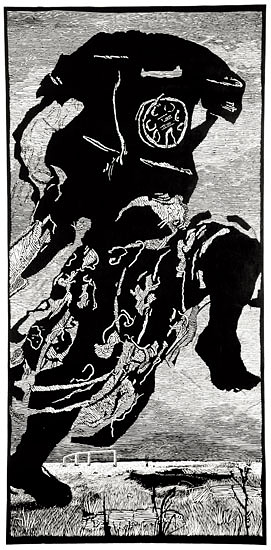Telephone Lady
Telephone Lady and Walking Man are large-scale linocuts created in 2000, around the same time as the film Shadow Procession, which had used articulated black paper figures to make an animation of a long procession trudging through a minimal landscape, carrying their worldly possessions – donkeys, carts, bundles, sometimes whole towns. The procession is a recurring motif in Kentridge’s work, appearing in animated films, drawings, collages, prints and an artist book, and relates to the grind of living within a system of sustained violence – apartheid in South Africa – and more generally to the many states of migration and displacement around the world.
Kentridge’s use of linocut in these monumental works is significant. Linocut has historically been the primary form of printmaking in South Africa because linoleum is a very cheap material, the tools are easy to use and a press is not required in order to make an impression on paper. Kentridge also suggests the link between linocut and the various missionaries who brought the technique to South Africa, and a link to the German Expressionists whose style is influenced by African masks. Of his use of the medium, Kentridge has said: ” It occurred to me that if etching and engraving have to do with the split in northern Europe between the Reformation and other ways of being, then linocutting corresponds to anti-colonialism, certainly in South Africa, to something that comes out of that struggle.”
– Text by Jacqueline Flint
| Artist: | William Kentridge |
| Title: | Telephone Lady |
| More about: | William Kentridge |
| Year: | 2000 |
| Artwork Category:: | Editions & Multiples published by David Krut |
| Media & Techniques: | Linocut on canvas, Linocut on Japanese Kozo 38gsm paper, Linocut on Tableau rice paper |
| Edition Size: | 25 on paper, 9 on canvas |
| Image Height: | 216 cm |
| Image Width: | 120 cm |
| Sheet Height: | 216 cm |
| Sheet Width: | 120 cm |
| Availability: | Available |
| Framing: | Unframed |
